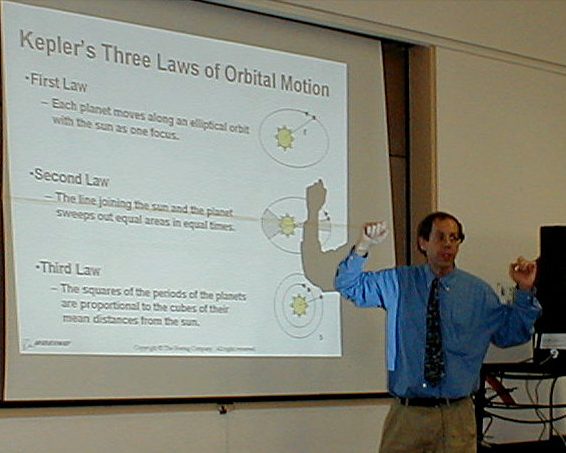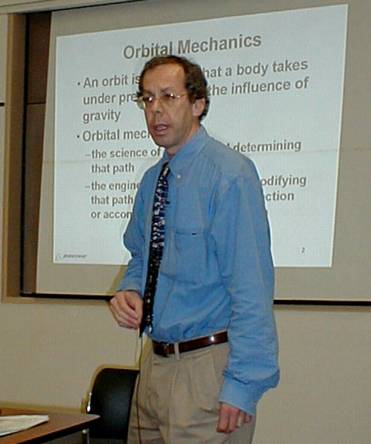Search this Site







The OASIS Lecture Series
Space Researcher Explains
Orbital Mechanics for Real People
By Steve Bartlett
 |
| Dr. Potter illustrating Kepler's Three Laws of Motion. Photograph courtesy Steve Bartlett. |
Mixing humor, wry asides, and rocket science, Dr. Seth Potter described the whys and wherefores of objects in space in his lecture, "Orbital Mechanics for Real People," on October 15. Potter briefed an audience of students, lay people, and space enthusiasts at the Long Beach Public Library as part of the OASIS lecture series on space science and development.
Dr. Potter, an advanced programs scientist for the Boeing Company in Huntington Beach and Seal Beach, in-formed the audience by starting with the basics: what or-bits were, their shapes, and why objects followed them. He gave definitions for the parameters that define where an object is located with respect to the sun or the Earth and what paths the object could follow. The paths depend on the orbiting object's velocity at a given point and on the mass of the object being orbited. These paths result from a balancing act between the force of gravity and the kinetic energy from the object's motion.
The orbits Potter identified were elliptical, circular, parabolic, and hyperbolic. Elliptical orbits may be thought of as "squashed circles" and are the most common for objects in space. Early astronomers plotted the paths of planets through the sky; Johannes Kepler used these data to determine the "rules of the road" for orbiting objects. When the force of gravity is equal to the centripetal acceleration (sometimes called the centrifugal force), an object will follow an elliptical orbit. Circular orbits are a special case of elliptical orbits and are common to many Earth-orbiting artificial satellites. The amount of an orbit's deviation from being circular is referred to as its eccentricity.
 |
| Dr. Seth Potter presenting lecture on Orbital Mechanics. Photograph by Steve Bartlett. |
Parabolic orbits are the paths that objects follow when their kinetic energy is not enough to balance the force of gravity. A baseball thrown into the air, a ball shot from a cannon, or a ballistic missile will follow a parabolic orbit.
In layman's terms, hyperbolic orbits occur when an object is moving too fast to travel in an elliptical orbit. Some comets follow hyperbolic orbits. They fall into the inner solar system from deep space at high speed, swing past the sun, and go back into deep space, perhaps never to return. When a company launches a communications satellite or when NASA sends a probe to explore Mars, the Moon, or some other object, they use the balance of gravity and kinetic energy to send the spacecraft on its way and ensure that it arrives intact. Dr. Potter described some particularly useful orbits around the Earth, including:
- Geostationary orbits above the equator, where a satellite circles the Earth at the same rate that the Earth turns on its axis, making the satellite appear to sit in a fixed position relative to an observer on the ground. This feature is particularly useful for communications satellites.
- Polar orbits, which allow a satellite to view the entire surface of the Earth.
- Sun synchronous orbits, which allow an imaging satellite to view locations on the surface at the same time of day relative to the sun.
- Molniya orbits, which are high inclination orbits used by Russian satellites to allow communication among people in far-northern latitudes, which would have a poor view of a satellite over the Earth's equator.
Potter commented that his personal focus was to educate our future space explorers and settlers. "The Real People are the ones who're going to go into space and those are mostly young people," he said. As if to emphasize this point, Potter gave the lecture twice, once for the main audience, and an abbreviated version for a group of high school students who arrived near the end of the talk.
Besides being a space researcher with several published papers to his credit, Seth Potter is the former president of OASIS and former head of the New York chapter of the National Space Society.
Copyright © 1998-2007 Organization for the Advancement of Space Industrialization and Settlement. All Rights Reserved.